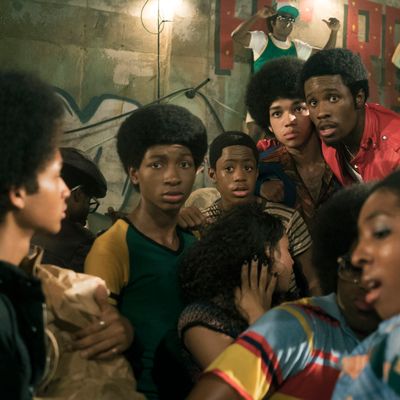
The Get Down, Netflix’s highly anticipated new show about the birth of hip-hop during the late ’70s in the South Bronx, focuses on the youth who simultaneously created a new music genre, art form, and fashion style. “These young people didn’t do it because they wanted to be rich or they thought their graffiti would be in a museum,” creator Baz Luhrmann said at a Television Critics Association press conference in Beverly Hills on Wednesday. “They were doing it because the world was saying, ‘You don’t exist.’ They were doing it because they were saying, ‘We exist.’”
Luhrmann appeared with supervising producer Nelson George, associate producer Grandmaster Flash, and some members of the cast, including veteran TV actor Jimmy Smits. The show’s first season, which covers 1977-1979, will be split into two six-episode cycles, premiering Aug. 12. (The second part comes out next year.) Here are a few things we learned at its TCA panel:
The idea to explore this cultural and musical period occurred to Luhrmann when he was sitting in a Paris restaurant ten years ago. He looked over the shoulder of his companion and saw a framed photograph of two kids by Jamel Shabazz. “They were in hip‑hop stance, and it was from what I thought was the ’80s. I remember thinking in that moment, Gee, how did so much creativity come from New York in that moment at that time? How did something so completely new, so totally unexpected, and so creative come about?” Luhrmann said. “It was just a question really. It just stuck in my mind. And from that point on, I started trying to answer the question.” Luhrmann said he didn’t intend to create a show from it, but as he learned more, he became increasingly intrigued. “I started to learn that, in fact, this wasn’t the ’80s; this was, like, ’77, ’78, and at the time at which disco was king. But in this borough, where there was so little, and the world had forgotten, and apparently the city had forgotten, these young people who were inventing with whatever they had. What can I do with records? or Can I take a spray can and put my name up there? Because, you know, Mama, when I see my name up there, I am someone. So I just started getting completely absorbed with this story, and I thought, how can I help get this made?”
Grandmaster Flash, who is an associate producer on the show, was annoyed by all of Lurhmann’s questions about the early days of hip-hop. But the first time he saw the footage, he understood. “It was quite an emotional moment because when we did this in the ’70s, we didn’t shoot it. We didn’t record this,” he said. “So now this particular era can now become a [topic] of discussion, because I’ve been trying to tell people this forever and ever and ever. [The] ’70s is where this thing really comes from. But when you have no documentation, it’s really difficult to explain that to people.”
Journalist Nelson George decided to join the project as a supervisor producer because Luhrmann chose the ’70s disco era as the entry point. “One of the things that was very attractive to me … [was that] he wasn’t doing the birth of hip‑hop. He was doing New York City [in the] 1970s, with disco having equal weight, with the context in which young people existed, which was budget cuts, crime, bad education, strikes,” he said. “So for me, even though I was one of the early writers about hip-hop, I also was very interested in the fact that disco was a huge part of the culture in 1977 and ’78.”
The Get Down begins in 1977, but there are flash-forwards to a Madison Square Garden concert that takes place in the ’90s. Hamilton actor Daveed Diggs plays an artist who rap-narrates the show. Nas, who is an executive producer, writes all those raps, Luhrmann said. “And it’s [Nas’s] voice. He is using the rhymes as a narration device all the way through it, and Daveed plays the character.”
The show depicts the strength of low-income black and Latino families.
“This show is not poverty porn,” George said. “We are not diving in and saying how horrible it is for all of these poor black and Latino people. We are saying how much positivity and how much family and how much strength it took to pull yourself out of that. The outside may have been tough, but families were together, they were strong, and they raised strong people out of the chaos.”
The actors trained in dancing, singing, and spinning in a house on the Queens set known as “The Dojo.”
“They went through this boot camp of choreography and immersing themselves on every level, every part of rap and what disco was,” said actor Jimmy Smits, who plays a Puerto Rican, South Bronx power broker who wears a wide-lapel leisure suit made from “poly or esther,” Smits joked. “I was just so amazed coming from that world and knowing what these actors were, whole hog, going into.” George said he loved walking into the house and witnessing everything come together. “In this section would be Rich & Tone, our fabulous choreographers, working with actors on how to do the Hustle. And this part here, would be a young actor [Mamoudou Athie] who was being trained very brutally by Flash in how to become a DJ,” he said. “And, then, on this corner here, it would be [Shameik Moore] and Floor Phantom teaching him how to break dance. This was like a boot camp on ’70s urban style that was happening for months before we started shooting.”

